Text
ALLEN (intro)
“It is precisely when practice and experimentation turn up inconsistencies in the “normal science” that new theories are produced.” (XII)
“Constantly mixing media in this way, material practices produce new concepts out of the materials and procedures of work itself.” (XIII)
We have spoken this semester of risk and surprise. Craft is risk, the evolutionary algorithm must produce surprising results to be worth our time, prototyping depends on risk and unknown to discover new systems—otherwise it would be a model not a prototype. Innovation in architecture happens in the gaps between what we know, in the processes of building and designing and creating in which we do not know the end result. Allen reintroduces this notion, speaking to how “theory” and “practice” are actually the same: practice produces theory, and in doing so makes theory another sort of practice. It’s architecture; our end results almost always take up space in the real world, and for that reason we are quite tethered to our realities which means our theories must constantly be acted upon, adapted to the world. They must constantly evolve, learn, grow.
“Tethered to a fast-moving reality, material practices need to be agile and responsive, which often requires that they leave behind some of the weighty baggage of received ideas” (XV). There is a constant back and forth between concept and making. Architecture has a responsibility to keep up with the latest technological innovations, the newest climates and cultures, and for that reason we do things like learn of building systems in our architecture class not in the details of plumbing and air conditioning, but in understanding geometry, tools, concepts of workflow that will keep us steady through a fast moving reality. It is our responsibility to refuse to think of architecture and architectural ideas as monolithic; they have to change rapidly, constantly.
“Architecture is of necessity a discipline of circumstance and situation.” (XI). We respond to clients and client needs. We respond to the world, the world responds to architecture in a recursive loop in which true innovation must result in the risk, the surprise, the unknown of this in-between. It’s been an interesting semester of learning methods and concepts that could be scaled up, scaled up, stretched and pulled in order to derive inspiration for architectural works. They’re tools, now, we adapt them.
2 notes
·
View notes
Photo



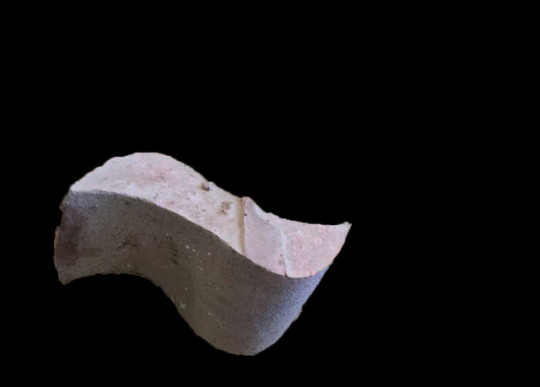




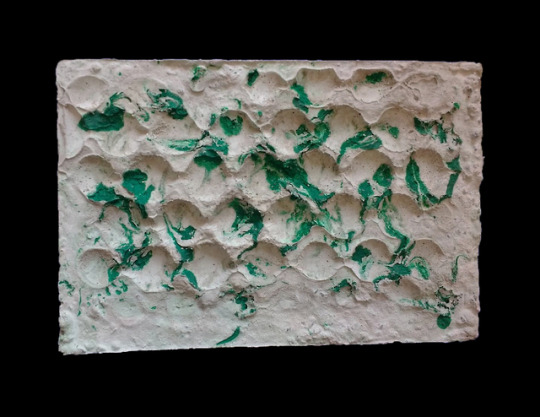
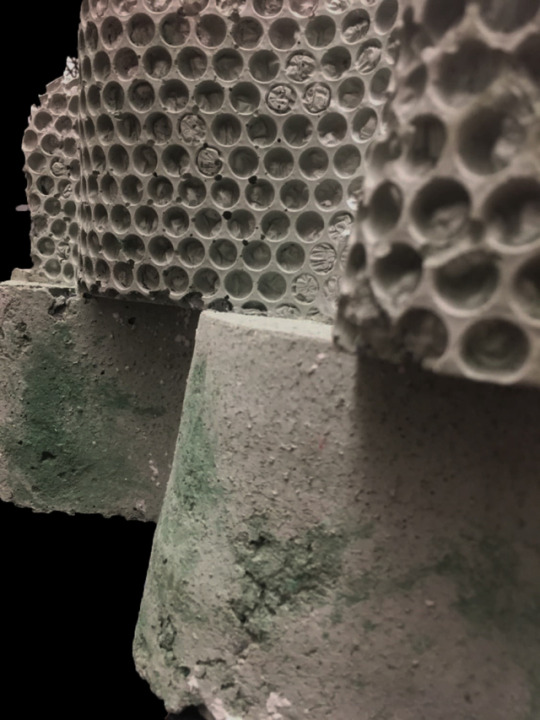
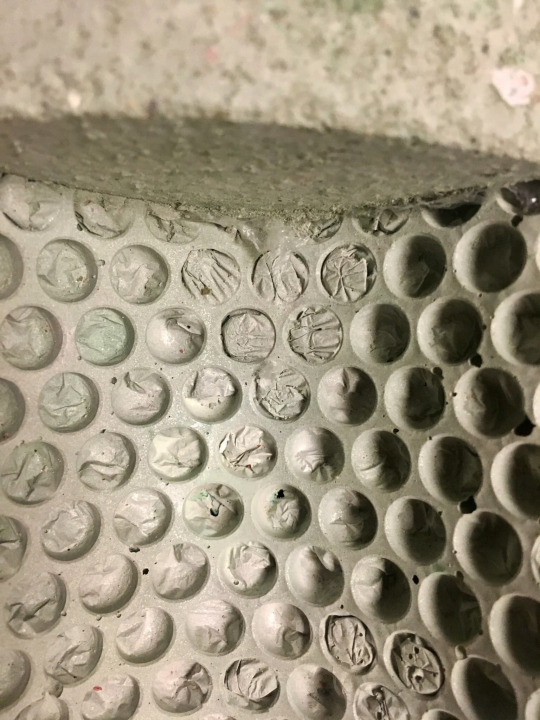
EXERCISE 7 PT 2
GROUP MEMBERS: Allegra, Clara, Anoushka
We flipped our casts to play with the gaps created in the middle to make generally smaller shapes. Our interest lay in adapting the concrete--we added color, we added bubble wrap for additional texture. Some of the color didn’t work (I’m looking at you, green) but overall, we made some fun objects.
This move to cast our foam speaks to Allen’s idea of the “trace” that we read about in that the final product (the cast) holds traces of the original form-work, the concepts of color and texture we hoped to imbue in them, etc. Though, like Allen points out, the process of construction destroyed some trace (bits of the concrete broke and crumbled).
0 notes
Text
CRAWFORD + PATTERSON
“American musicians are frantically running up and down, all over the finger-boards of their violins, viola and cello, grasping at hundreds of different ‘tones,” …still trying to find their unique, personal “tone”” (Patterson)
“A jig is a device or procedure that guides a repeated action by constraining the environment in such a way as to make the action go smoothly, the same each time, without his having to think about it.” (Crawford, 31)
“The jig as it is used in a skilled practice is located somewhere between the overdetermination of the assembly line and the ideal of autonomy.” (Crawford, 34)
“A number of metaphors have been suggested: we "offload" some of our thinking onto our surroundings, or we incorporate objects in such a way that they come to act like prosthetics.” (Crawford, 35)
At first pass it was difficult to determine the parallels between Patterson’s treatment of tone, and the field of architecture. But upon closer reflection, the ideas are many; architecture began as an interdisciplinary field (Vitruvius’ 9 required disciplines, for example, which included medicine and law) and continues casting a wide net today, with a move toward more software/technologically literate architects. We have many “tones” we are expected to use, master, weave together, all while trying to find our own “voices” or our own brand of authorship. Is there, perhaps, something useful to learning to do one thing well, not having the architect do everything, but having the architect gather a group of other specialists to work together? Does architecture, perhaps, move toward an interdisciplinary field in the adoption of other specialties in to supplement or drive us, without putting the burden of knowledge on a single individual? I think it should; let the software engineers and the structural engineers and the interior designers and the architects etc etc work together to play many tones together, to make music together. (Still don’t know what, exactly, an architect would be responsible for doing, but I’m not sure we’ve really ever known).
Crawford’s discussion of the jig also plays into his conversation. The jig is a mechanism for “offloading” thinking onto others to streamline a process. Between autonomy and assembly line, if other specialists or specialties were to function as a sort of “jig” to architecture in order to offload some thinking to focus on other areas, we move toward a field more meshed with the world. If we take robots to be “jigs” constrained by an environment to repeat the same action again and again without too much (too much, still some) thinking on the part of the programmer, then we see another way in which architecture utilizes the jig to design and build. “Architecture” is a broad term, if we take our desks and our lamps and our buildings and our everything to be architecture, and it seems impossible for one person to do it all (that’s why we have architecture firms, for collectives), but if we jig our environments with engineers and geoscientists we find a way to keep the field of architecture on the forefront of innovation.
1 note
·
View note
Video
From Series 1: A wire-cutter attached to a robot arm reinvents Canova’s sculpture
1 note
·
View note
Photo
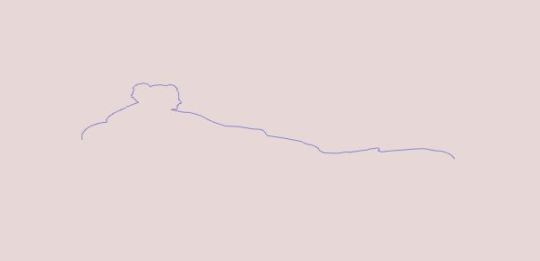






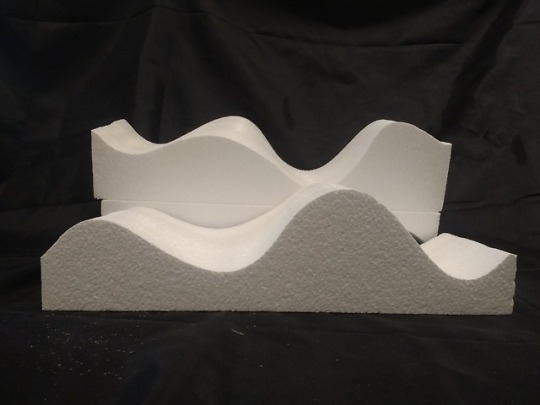



EXERCISE 7 pt 1
GROUP MEMBERS: Allegra, Anoushka, Clara
DESCRIPTION: The dark blue curves play with the different faces (one is a mainly straight line, the other rolling waves.) The turquoise and pink were designed so that if they were mirrored and flipped they could fit into themselves on the edges, but with a gap in the middle that concrete could be cast into.
The lavender shape is the sculpture Pauline Bonaparte as Venus Victrix by Antonio Canova. We wanted to use the robot to recreate a famous work of art to interrogate concepts of authorship.
0 notes
Text
ALLEN
“The result is a self-referential architecture, locked in the examination of its own history” (54)
“traces as indexical signs, the trace as absence and erasure, and the trace as regulating geometry” (64)
In much the same way Mark and Jane Burry spoke about “workflow,” Allen’s treatment of the ‘traces’ of architecture call to process. Whether it is these traces as indexical signs of concept to final product, of construction as erasure, or trace and geometry, trace speaks to a constant mapping of what you end up with and how you got there. Initial idea and final project are points, process and workflow make up the lines and paths. Again, we touch on notions of authorship—do architects primarily author their workflow or their products? I personally think we have a better and more individualized claim to workflow, as that is our hand primarily, whereas construction grants work to others, and even the tools we work for representation can perhaps stake a claim on the product. This workflow plays into notions of the prototype, the evolutionary algorithm, Haraway’s interest in the process of “becoming.” We have spent the semester concerned with process, uploading process images every week etc. Perhaps architecture can be understood in terms of concrete objects, but architects can only be understood as part of process.
Allen also brings up what I found to be an extremely interesting point: that of self referential architecture. If the traces left on final product constantly refer back to the process, the system is a closed one. Innovation, in this space, could therefore only take place via a mode of “trace breaking.” An object that does not refer to itself, something that calls to a wider world. I have no idea how this would be possible, as trace seems to be irrefutable. Perhaps it’s in the way we speak about architecture, not in terms of “I sheared the shape” or “this is a rotated rhombus” aka, not in terms of modified geometries, but perhaps with different interests.
1 note
·
View note
Photo
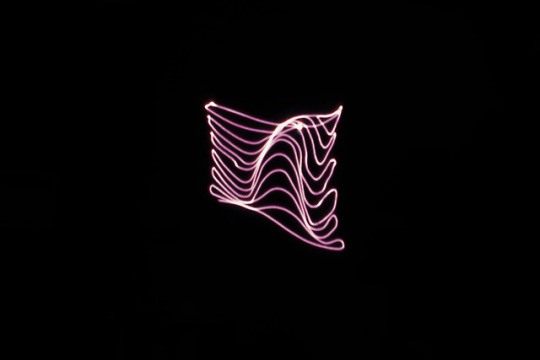

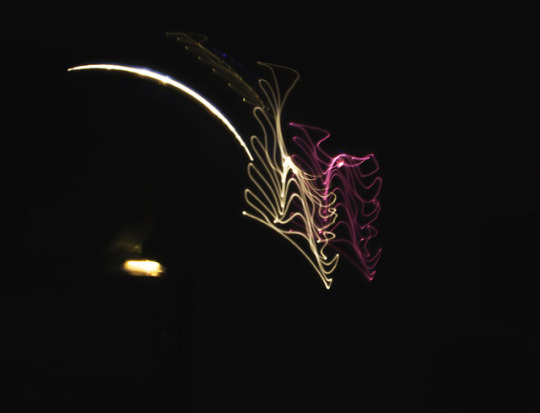
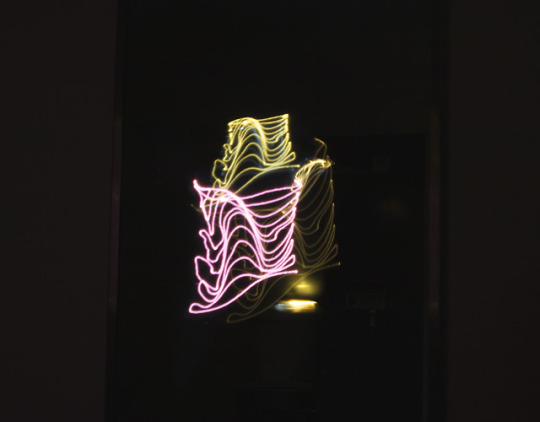
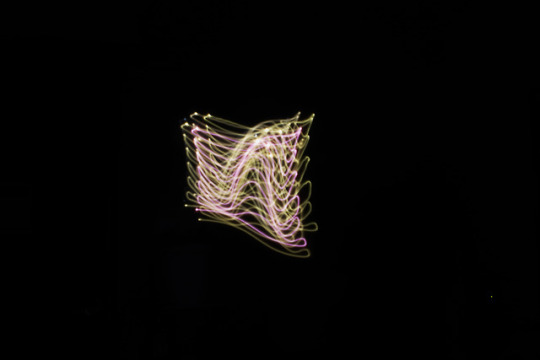


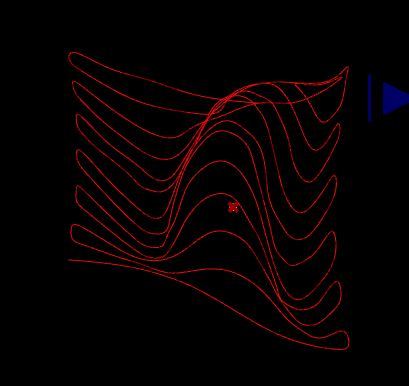
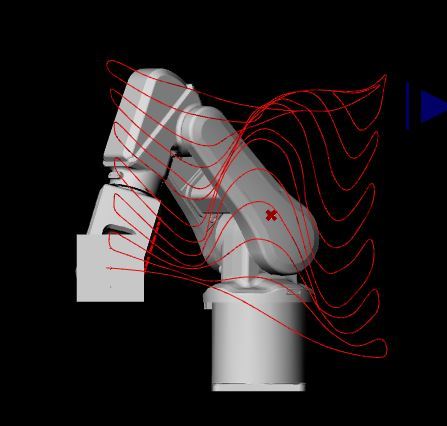

EXERCISE 6
GROUP MEMBERS: Allegra and Yunzi
I noticed we got a lot of errors when the curve was placed directly in front of the robot but angling it to the robot eliminated them.
Yunzi and I attached lights to the joints of the robot to see how they moved (yellow lights) in contrast to the main face (red light). Interestingly, many of the joints (4, 3, 2) imitated the curve. Axis 1, however, was a blob.
We chose our curve by creating a mesh and then tracing over part of the design to imitate the general shape of mesh surface while still being a doable curve.
The overlaid curve (picture 5) arose when we attached 5 lights to the main point surface.
1 note
·
View note
Text
AHMED
When Grey explained the ECL robot axes to us he likened them to a human body. Axis 1 = hips, 2 = shoulders, 3= elbow, 4 = forearm, 5 = wrist, 6 = flick of the wrist. Ahmed explores a human tendency to equate parts to whole as we equate limbs to the body, and though she focuses on a social “body” this notion is applicable to robots as well. It is a robotic “arm” after all. We describe them as having “joints” and we are constantly comparing them to humans in what they (and we) are capable of. When the ECL robot encountered a singularity, one or two “limbs” falling out of line with the will of the whole, the entire system grinds to a halt. If all parts do not function together then there is discord, if one of the limbs or joints were to “wander” out of place, this rebelliousness of the code and machine would bring great unhappiness to us, the controllers and will of the robot, and perhaps the robot itself, resulting in a singularity. There is then the process of bringing the limbs back under the will of the whole to guide it out of that tight spot and bring it all back together. When the robot moved linearly it was all limbs moving as one. When we, as the controllers of the robots, moved it, we became the will, asking the limbs to function as we demanded.
When we offer robots as substitutes for workers in the construction business we retain all the previous connotations surrounding laborers as the “feet” or “legs” of construction. While there are, perhaps, fewer ethical conundrums to face with a robot doing heavy lifting instead of a worker, these robots now inhabit a once-human place, and in doing so, I think gain some human characteristics and connotations. The fact that humans can be replaced conjures notions of laborers are inhuman, automated, faceless. We liken these laborers to these robots and vice versa.
1 note
·
View note
Photo
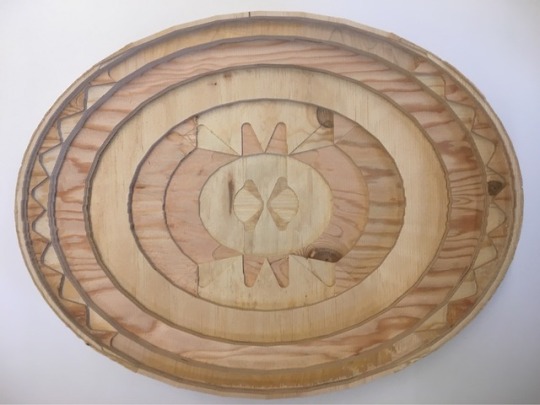


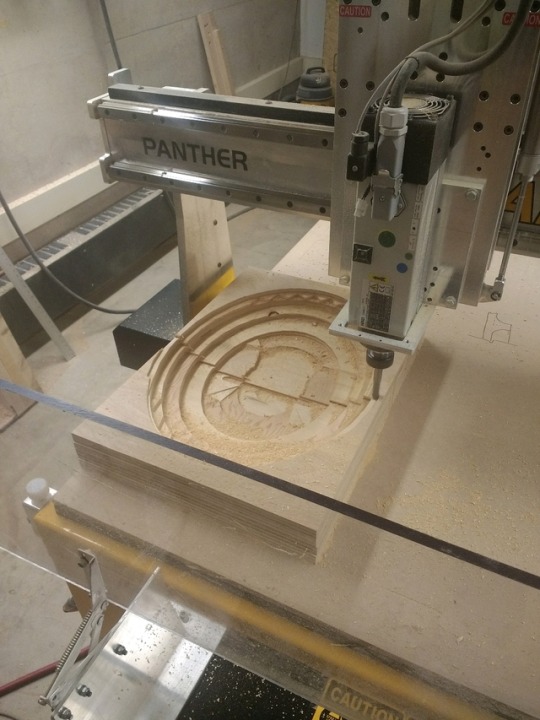
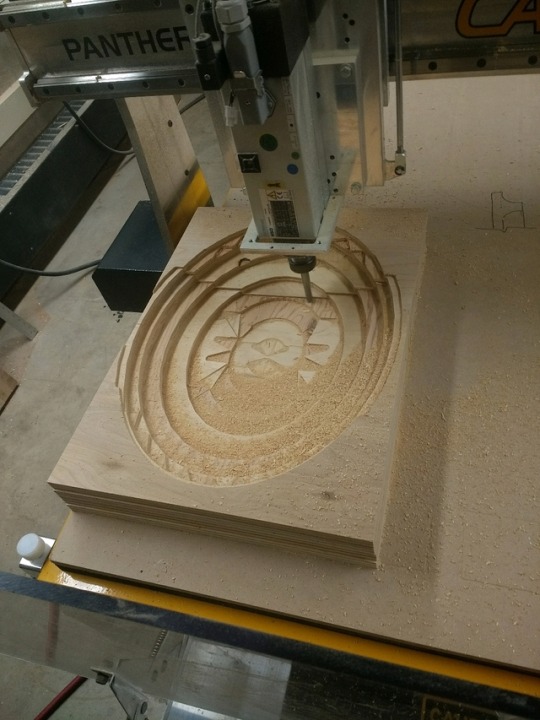
EXERCISE 5
GROUP MEMBERS: Allegra, Amelia, Yunzi
Final Product
0 notes
Photo
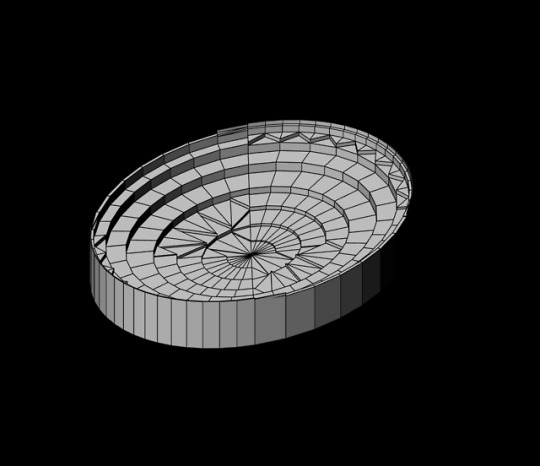
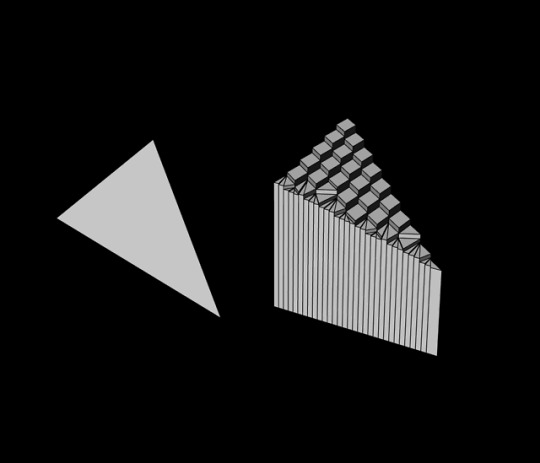
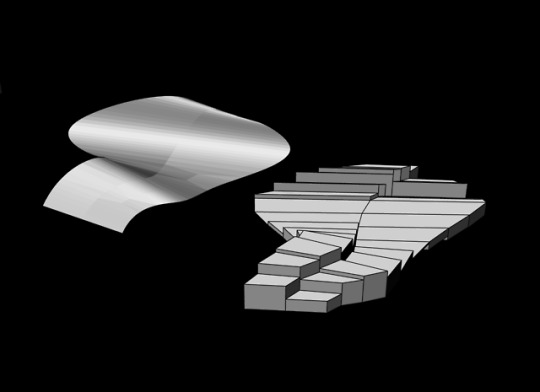
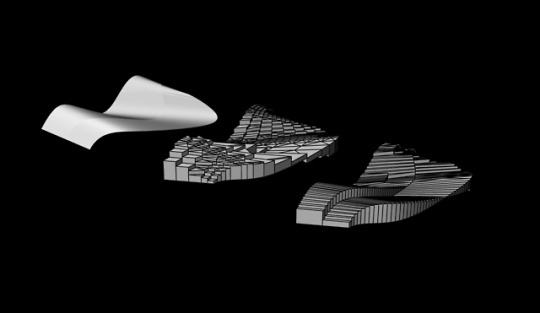
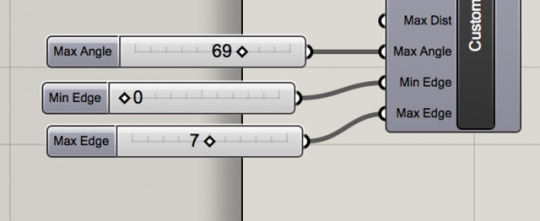
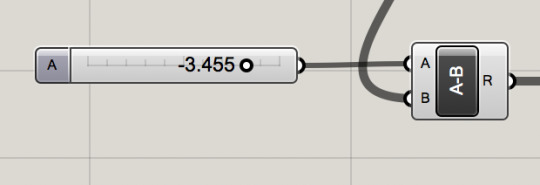
EXERCISE 5
GROUP MEMBERS: Allegra, Amelia, Yunzi
8) Max angle, Min Edge, and Max Edge can all be changed for interesting results.
9) The number slider can be a floating point number (and should be for increased nuance in height). To determine height you need essentially a “height from” --this is the number slider we insert. It is a subtraction (and not, say, an addition) because the subtraction makes it flat on one side (instead of extruding in both directions). We made the number slider values negative (max 0) so that it would extrude “down” instead of up.
10) The surface does not have to be lofted--the only requirement of the surface is that it can be turned into a mesh (doesn’t intersect itself). thus, a euclidean object can be used to create the object. It is best if the object is not oriented so that it is parallel to the xy of the world axis because if it is there will be no height differences and the surface will subdivide but remain flat. You can, however, rotate a Euclidean object so that it is angled against the world axis for fruitful results.
We milled based off a warped sphere, using a solid to define our surface areas and manipulating angle, min, and max edge for additional results. We did so to test the limits of what the surface could be; a closed shape. And we chose a regular shape to see if we could get irregular results by manipulating the variables (this is how we got the triangles inside the shape). It is a circular object with flat rectilinear planes inside, and triangles as well and so demonstrates a lot.
i wonder if we could have used our reactive surfaces as a templates/in conjunction with this exercise to add a 3rd dimension to what was a 2d project. or the Sol LeWitt might create interesting geometries. And we are milling out of plywood sheets, but making them have unusual geometries, thus pushing forward architecture and possibility by experimenting with classic, extracted sheet material.
1 note
·
View note
Text
BURRY + BURRY + KOLAREVIC
“A prototype tests the reality of something” (Burry, 142)
“Italian architect Benedetta Tagliabue notes that…the prototype is mainly something for the architect. It is a step in the process of transforming a design little by little, to ensure that everything is working. It should also be something you have not seen before” (Burry, 74)
“craft is understood as a set of deliberate actions based on continuous, iterative experimentations, errors, and modifications that lead to innovative, unexpected, and unpredictable outcomes, discovered in the intertwined processes of conception and production.” (Kolarevic, 127)
The Burries (please bear with me while I call them that) offer the prototype as something other than “the model,” something exploratory to test the viability of a concept. “It should be something you have not seen before” (74) which is a theme that arises in Kolarevic, and popped up in DeLanda’s treatment of the genetic algorithm. The results must surprise, DeLanda said, the craft of architecture should “lead to innovative, unexpected, and unpredictable outcomes” (Kolarevic 127) Kolarevic says. This emphasis on creating something unexpected and often iterative places craft making, whether by hand or through digital fabrication methods, as a means of design itself instead of just representation. The prototype serves as a means of experimentation.
This act of the prototype being used to design, in conjunction with drawings and modeling, etc. harkens back to Donna Haraway and the act of sympoiesis, or “becoming with.” Architecture moves towards collaboration; between methods of experimentation, between software engineers and designers, between materials. The Burries note that software engineers know how to work together, while architects, classically used to working alone, still cling a bit to this solo endeavor, but the world moves toward sympoiesis. In parametric design “interdependencies between objects are established, and objects’ behaviors under transformations are defined. These interdependencies become the structuring, organizing principle for the generation and transformation of the geometry” (Kolarevic 121). The act of designing with technology, with (as Iwamoto introduced) experimenting with sheets of known material (laminated plywood, metal, etc) to create unexpected results is a means of becoming with the machine. The CNC mill carves out what I cannot do by hand, but I create the design. Without the information I create, the mill has nothing to do, without the mill, I can’t carve the designs. I am bounded by the limits of the machine and the machine is bounded by my (growing) knowledge but together we create an object, and in doing so investigate a concept—drive an idea forward, test the reality of something.
1 note
·
View note
Video
EXERCISE 4.5
it was oddly light and felt sort of like a football.
0 notes
Photo



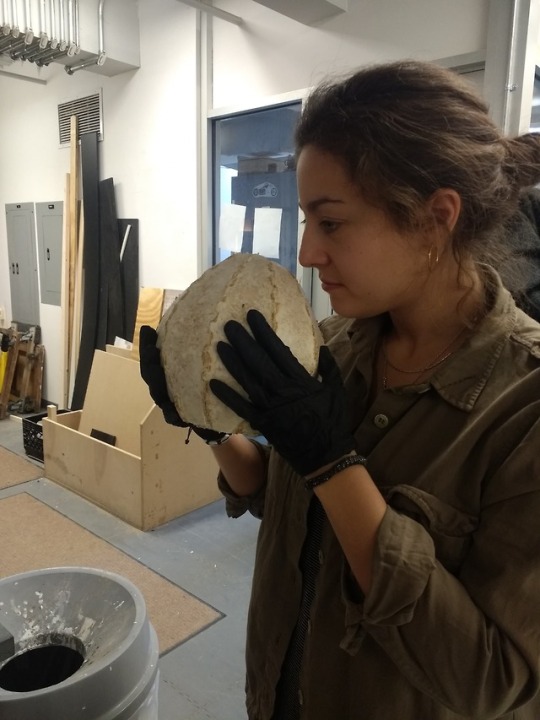


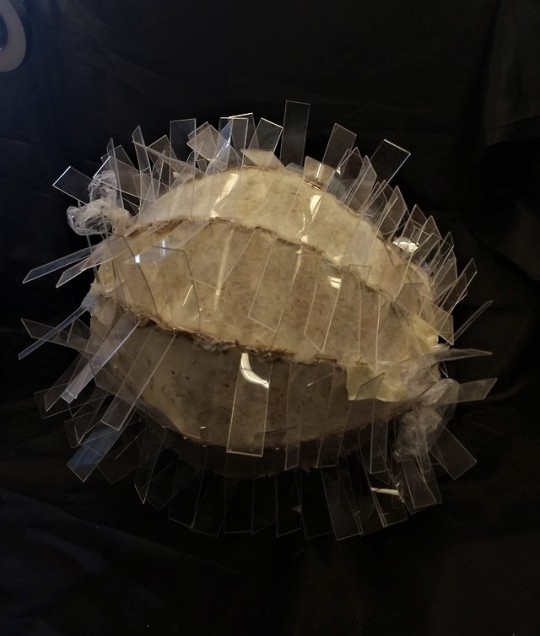
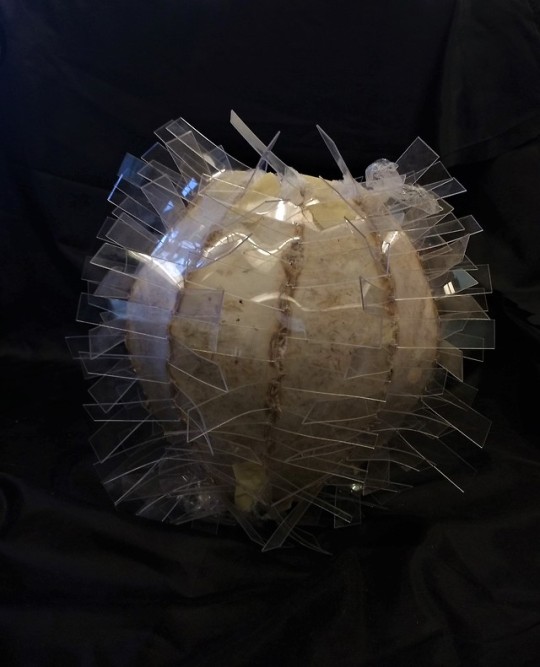
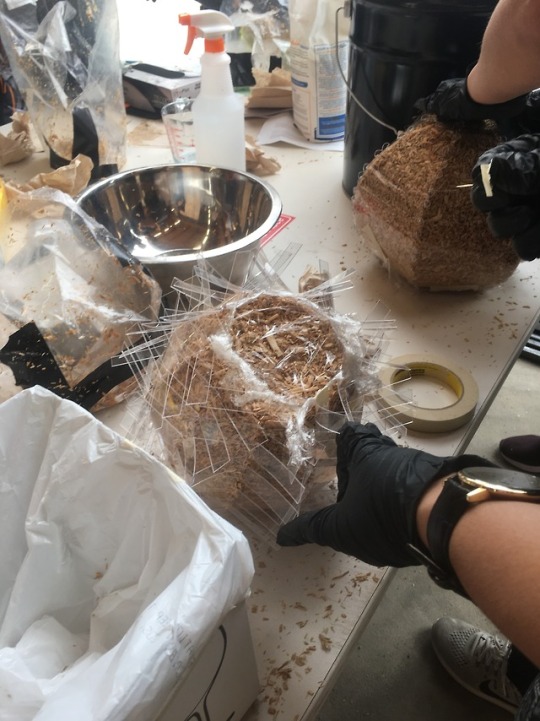
EXERCISE 4.5
This exercise used the “Beast” object from Exercise 4 as a mold for mycellium. The end result is makes clear what the basic form of the mold was and stands in contrast to the form made when the plastic tabs are considered. The top and bottom got contaminated but the middle areas held up quite well.
0 notes
Text
IWAMOTO + DELANDA
“Architects have experimented with sectional assemblies as a way to produce both surface and structure.” IWAMOTO
“the only way to ensure that structural elements do not lose their function, and hence that the overall building does not lose viability as a stable structure…” (10) DELANDA
Delanda and Iwamoto found common ground in their treatment of fabrication technique and subsequent structure. Iwamoto’s focus on sectioning, a classically representational move that has, through computer aid, become a tectonic property, is being used to produce structure. While the examples given were, in large part, installation driven rather than structural (except, perhaps, BURST* House) there is an interest here in Making The Thing Stand or Making The Thing Function. Iwamoto is concerned with ways to push forward the bounds of architecture by molding new design processes, taking a drawing and making it stand up, taking a surface and making it solid. This move melds the information-rich representational work of architects with new forms of building aided by technology—a tool that inherently needs information fed into it. It is, in a way, the next logical step. And it does, as has been pointed out, draw together the drawing and final product, turning architecture back into an autographic art in which the architect controls the process.
Delanda also focuses on design process but draws more on a biological process. This is the evolution of architecture, perhaps less a next logical step and more, the next node of evolution (regardless, Iwamoto and DeLanda agree that architecture is a force driving forward.) This evolutionary algorithm is information fed into a computer to create parameters to spawn forms. To spawn many forms, to mass produce and choose the “best” ones. Though this process delegates the architect to “racehorse breeder” in that they are merely selecting desirable bloodlines (graphic properties) it does grant architecture status as a living entity (something we have experimented with/continue to experiment with in our work with mycelium). DeLanda works through how to make this evolutionary process viable, and one of their focuses is how to make it structurally sound, or, again, Making The Thing Stand. Too much mutation and the column no longer bears loads, the parameters must focus on how to keep the basic tenet of architecture; it must be structurally sound. Here we adapt and control (to an extent) a biological process to “grow buildings” and what DeLanda and Iwamoto agree on is that there is still a need to make this process a solid. There is a need to take surfaces and make them solids, these material experimentations still need to stand, and so still need to create space, and so racehorse breeder or not, hacker-architect or not, the architect still remains an organizer of space and process. A designer, a decision-maker, an author. It’s just the architect must have more and more familiarity with materials and technology to build, adapt, mutate, evolve, take the next logical step.
0 notes
Text
Carpo
“For centuries, this mediator was essentially geometric: architects had to use two -dimensional drawings to script the forms of three-dimensional objects. They did so using the conventions and under the constraints of a geometrical language that, like all languages, was never universal or neutral” (32)
“Under the former dominion of geometry, what was not measurable in a drawing was not buildable. Now all that is digitally designed is, by definition and from the start, measured, hence geometrically defined and buildable.” (34)
We have been discussing geometry as possibility; break any design down to its basic definitions (lines, points, figures) and you can build it. Construct a problem out of lines and equations and a computer can read and produce it. Carpo proposes geometry as a limiter of potential when it came to architectural representation, but a creator of opportunity when applied in a computer. His tone seems to be anti-geometry in parts but I believe the computer’s ability to measure and produce work does itself draw on geometry, so I interpret his use of “geometry” as referring to a more contained, Euclidean version.
What is key in his writing is that geometry measures, there is something in this piece very much interested in information and how architects convey it, how builders will know what to build. Geometry is focused on less as a generative process (the construction of a problem) and more as a mapping process (the measuring of a problem) and it is in this shift that he proves that computers have made possible the construction of non-geometrical forms by merit of being able to track their measurements.
This concern with building also links the architectural design process with real world scenarios; he makes the point that architects have the role of conveying information to builders to construct, they are not constructing themselves and do not technically need to be on the site. It speaks to the collaborative nature of architecture—the information flow—and also highlights the importance of legibility of representation and in doing so emphasizes architecture as a technical art.
0 notes
Video
EXERCISE 4
GROUP MEMBERS: Allegra Martschenko, Amelia Kenna, Genevieve Garlock
DESCRIPTION: Assembly process
0 notes
Photo
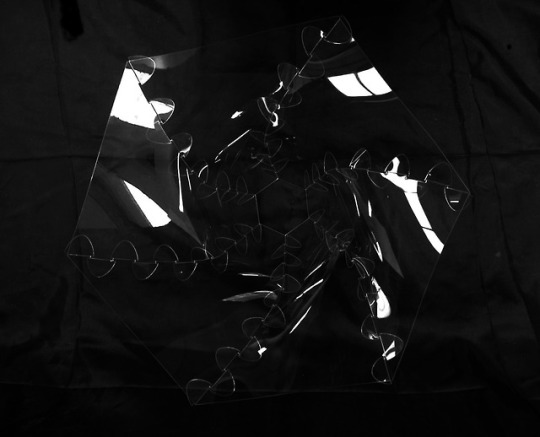
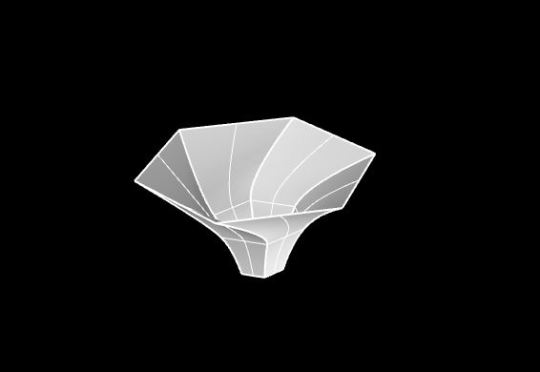
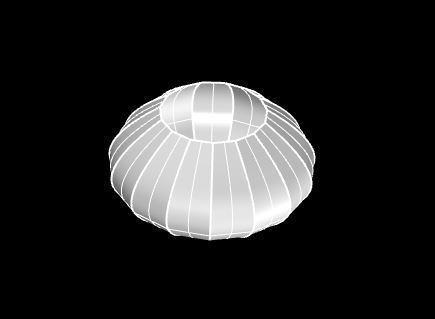

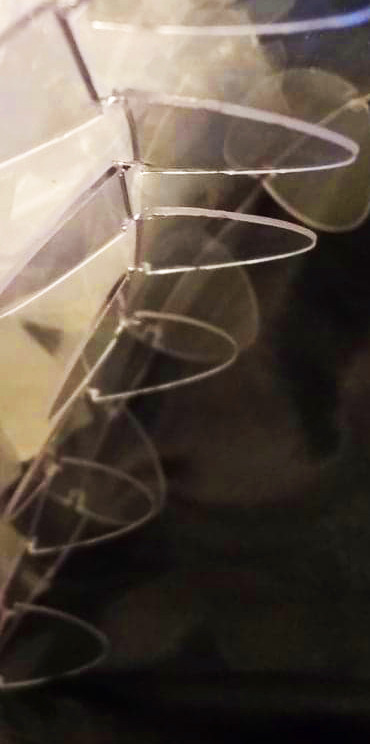

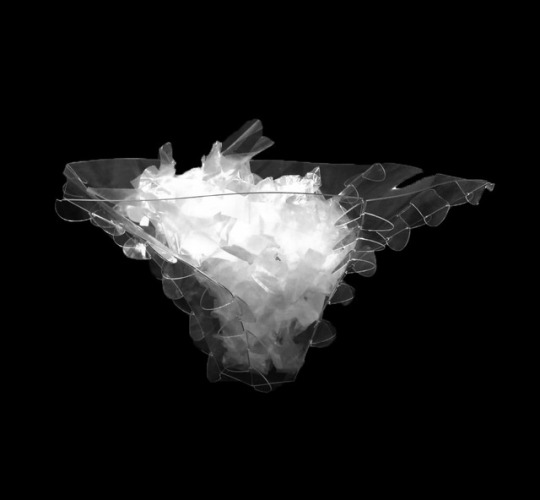
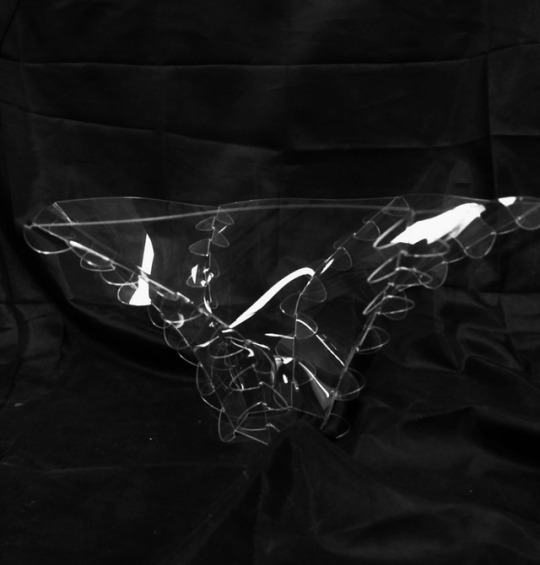
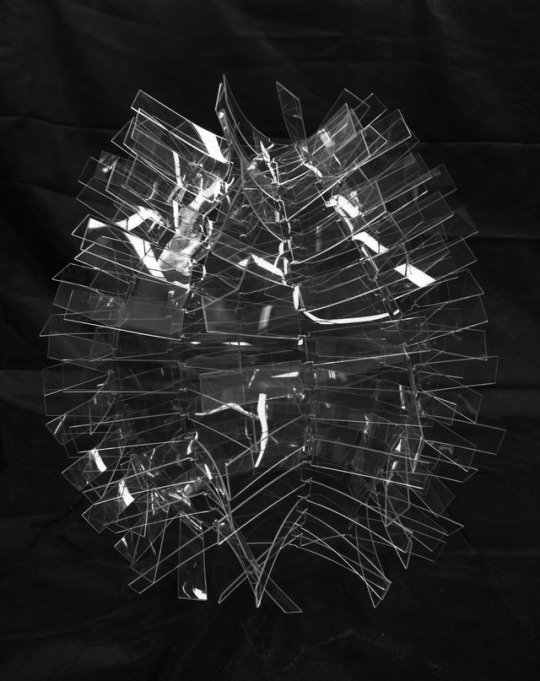
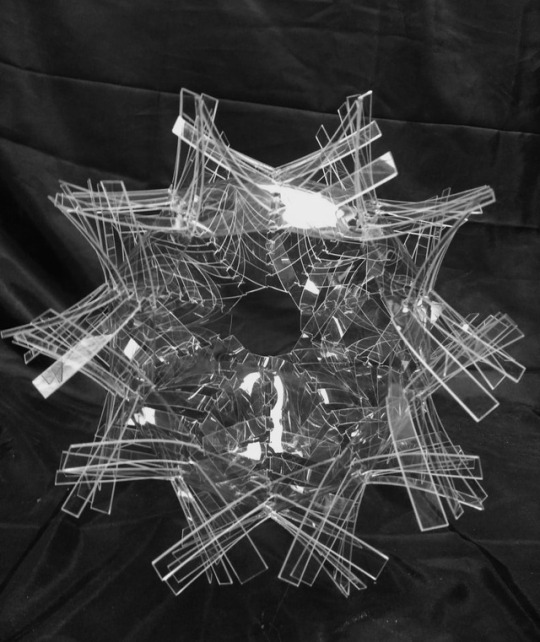
EXERCISE 4: Unrolling a Developable Surface.
GROUP MEMBERS: Allegra Martschenko, Amelia Kenna, Genevieve Garlock
DESCRIPTION: Our first model (the hexagon based, gramophone inspired one) pulled the profile curve in the x, y, and z plane to create a double curvature to test the possibilities of plastic. We filled it with trash in one photo both to throw it into contrast with its background as well as to highlight the waste that was produced in the process of building the model--despite being a recycled plastic it is still guilty of producing more plastic and thus more pollutants.
Our second model (the spiked beast) uses a simple curve as a base to create a donut, but experimented with the tabs. We knew that part of the allure of plastic is its transparency--so we moved to manipulate that. We added as many tabs and as many sides as we reasonably could and then lengthened the tabs, moving to create an object chaotic with overlapping plastic that would complicate transparency. In doing so, we emphasized the reflectiveness of the surface, creating a dense, hard to read piece out of a see through material.
1 note
·
View note